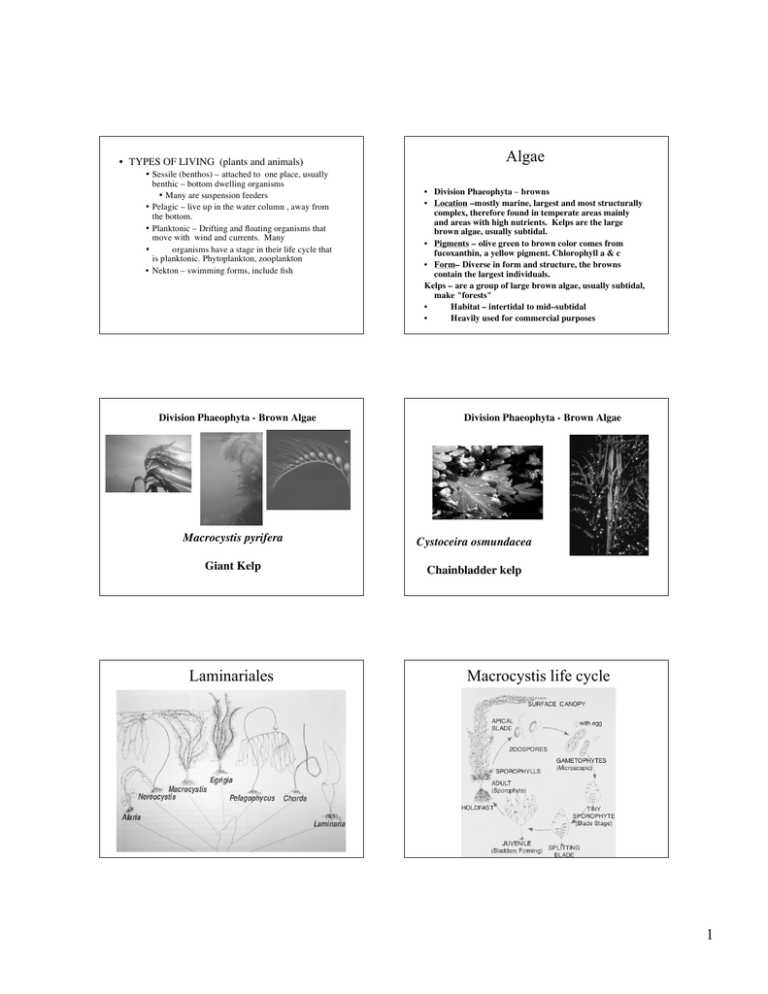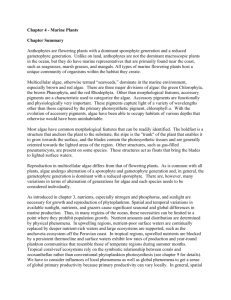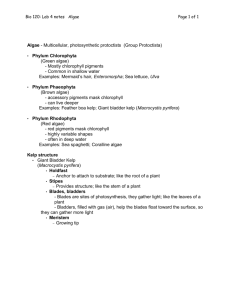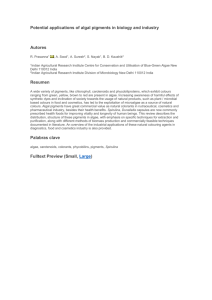Algae • TYPES OF LIVING (plants and animals)
advertisement

• TYPES OF LIVING (plants and animals) • Sessile (benthos) – attached to one place, usually benthic – bottom dwelling organisms • Many are suspension feeders • Pelagic – live up in the water column , away from the bottom. • Planktonic – Drifting and floating organisms that move with wind and currents. Many • organisms have a stage in their life cycle that is planktonic. Phytoplankton, zooplankton • Nekton – swimming forms, include fish Division Phaeophyta - Brown Algae Algae • Division Phaeophyta – browns • Location –mostly marine, largest and most structurally complex, therefore found in temperate areas mainly and areas with high nutrients. Kelps are the large brown algae, usually subtidal. • Pigments – olive green to brown color comes from fucoxanthin, a yellow pigment. Chlorophyll a & c • Form– Diverse in form and structure, the browns contain the largest individuals. Kelps – are a group of large brown algae, usually subtidal, make "forests" • Habitat – intertidal to mid–subtidal • Heavily used for commercial purposes Division Phaeophyta - Brown Algae Macrocystis pyrifera Cystoceira osmundacea Giant Kelp Chainbladder kelp Laminariales Macrocystis life cycle 1 Division Rhodophyta - Red Algae Algae • Division Rhodophyta – red algae • Location – mostly marine, most abundant in species • Pigments – chl a and d, phycobilins, a wide variety of carotenoids • Form – ranges from thin film, to upright, foliose. Some forms secrete CaCO3 in the skeleton – tropical • Habitat – intertidal to deepest subtidal (to 250m) Gigartina corymbifera Turkish towel Algae • Division Chlorophyta – greens • Location – mainly fresh water • Pigments – chl a and b, same as terrestrial plants. Chlorophyll not masked my other pigments and therefore bright "grass" green. • Form (marine) – filamentous or sheet–like • Habitat – upper portion of the photic zone, intertidal mainly. Some are associated with eutrophic areas (rich in nutrients) Sea grasses • • • • • Division Anthophyta – flowering plants or "higher" plants, seagrasses only marine plant. Dune plants that are adapted to high salt environments are also in this category. Location – mainly terrestrial, shallow marine – mud and rock substrate Pigments – chl a and b, same as for terrestrial plants Form – have true roots, stems, and leaves. Tissue is present to carry water, nutrients, and food manufactured by photosynthesis. Habitat – most in nearshore "meadows" on rock or muddy substrate, usually calmer waters in bays, estuaries. Temperate and tropical Angiosperms - Graminae Phyllospadix sp. Surf Grass 2








